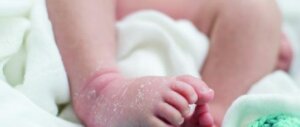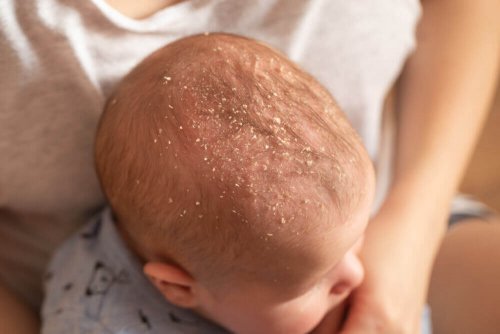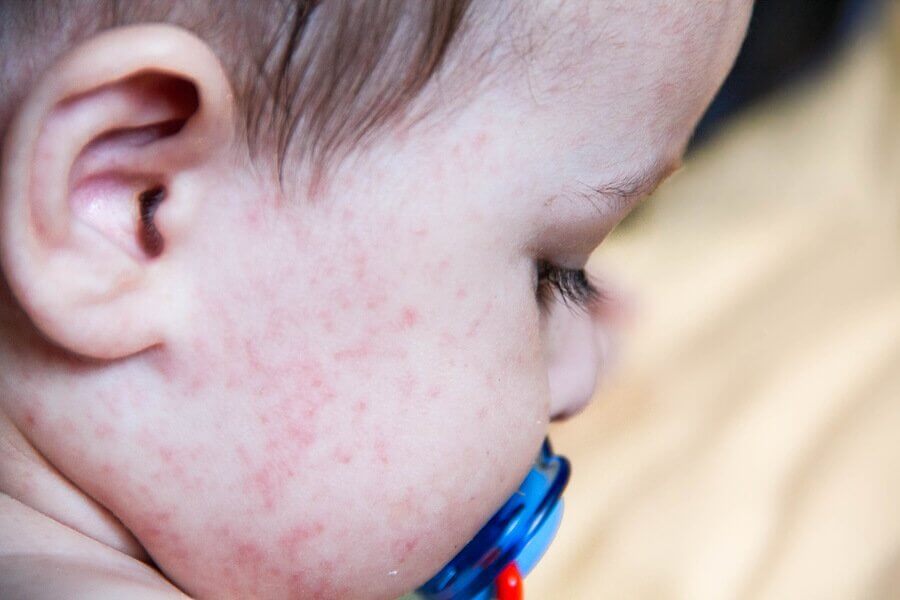10 Most Common Skin Conditions in Babies


Written and verified by the dermatologist Maria del Carmen Hernandez
A newborn baby’s skin differs a lot from an adult’s skin. It’s thinner, has less hair, and fewer sweat and sebaceous glands. Because of that, there are skin conditions that are common in babies. While the vast majority of them are benign conditions that will resolve on their own, it’s important to get a skin specialist’s diagnosis. Keep reading to learn more about the most common skin condition in babies.
Most common skin conditions in babies
Although the most common skin conditions in babies are usually benign and self-resolving, you should still go see a specialist.
1. Cradle cap, one of the most common skin conditions in babies
Cradle cap is characterized by scabs on a newborn’s scalp. In addition, you can even see slight redness around the scabs.
This condition tends to heal on its own, and usually doesn’t require any type of treatment. However, you can carry out specific hygienic measures at home in order to speed up the process. This will also help you remove the scabs more easily.

2. Diaper rash
This condition includes any rash that develops in the area that a diaper covers. The majority of cases are the result of a chronic irritant coming in contact with the skin. These are some of the causes of this condition:
- Urine enzymes
- Cleaning
- Rubbing
- Feces
However, the most important factor when it comes to a diaper rash is humidity in that area. Greater humidity destroys the epithelial barrier’s function and makes it easier for irritants to penetrate it.
Discover: 10 Types of Dermatitis in Children
3. Oral candidiasis
A specialist will diagnose oral candidiasis through clinical tests. This condition is characterized by the presence of white spots on the surface of the oral mucosa.
In most cases, oral neonatal candidiasis develops in immunocompromised patients. For example, it could develop in people that have a decreased immune function in the oral or systemic cavity.
4. Miliaria
Miliaria is a very common skin condition that develops because of a blockage in the eccrine sweat glands and their ducts.
This plugging then presents itself as sweat-filled vesicles under the skin. It’s also more common in hot and humid climates during the summer months. The rash is usually the only condition associated with this condition, and it tends to resolve on its own, regardless of treatment.
5. Atopic infant dermatitis
Atopic dermatitis is one of the most common skin conditions in babies and infants. This condition presents itself as chronic and pruritic cuts on the skin.
These cuts are usually recurrent and will develop between 3 and 6 months of age. According to studies published by the Journal of the American Academy of Dermatology, there’s a 20% prevalence in children aged 3 to 11 years old.
6. Toxic-allergic rash
Toxic-allergic rashes in newborns, also known as neonatal toxic erythema, is a benign, self-limited, and asymptomatic disease that can only develop during the neonatal period. It has an affection rate of 30 to 70%.
In addition, it’s one of the most common benign and self-healing skin conditions in neonates. Also, specialists aren’t certain about its causes. This condition presents itself as erythematous lesions with a central papule or pustule. They tend to show up on the face, bottom, and nearby extremities.
7. Newborn urticaria
This condition is more commonly known as hives. It’s characterized by recurrent, migrating skin rashes. Hives result in red spots that tend to itch. Fortunately, they tend to disappear after a day, except in cases of vasculitis and pressure urticaria, where they last longer.
Keep reading: Children’s Allergy Tests: What Do They Consist of?
8. Neonatal acne, another one of the most common skin conditions in babies
Neonatal acne will show up within 30 days of the newborn’s life. This condition is usually benign and will go away. In most cases, you’ll see closed comedones on the forehead, nose, and cheeks. However, that doesn’t mean that they can’t show up in other places.
Neonatal acne tends to disappear spontaneously within 1 to 3 months, so we don’t recommend treatment. Also, you should know that your baby could even have open comedones, pustules and inflamed papules as well.

9. Benign pustular melanosis
Pustular melanosis is a benign, idiopathic and transitory skin condition. In addition, it’s more common in Black babies. You may notice this condition in the following areas:
- Forehead
- Neck
- Upper chest
- Sacrum
- Thighs
Small vesicles, pigmented macules and superficial pustules appear on the skin, but they’ll disappear when the baby is 5 days old. This condition is self-limited and isn’t associated with mortality or morbidity.
10. Milium
Milium is one of the most common skin conditions in newborns. With this condition, you’ll see tiny yellow or white cysts filled with keratin on your baby’s skin. In addition, this condition affects almost half of healthy newborns.
They appear on the cutaneous surface of the face, from the lower infundibular sebaceous neck of the hair follicle. In addition, the condition will resolve on its own after a few weeks. However, they sometimes will stay and spread on the body.
A professional will diagnose milium based on the clinical characteristics of the lesions, but your baby won’t need specific treatment or management.
Skin conditions in babies
Skin conditions are common in newborns. That’s because skin issues are very common during the first 4 weeks of life. Although most are innocent and transitory, you should still see a doctor for a consultation. They’ll be able to diagnose the condition and rule out a more complex issue.
A newborn baby’s skin differs a lot from an adult’s skin. It’s thinner, has less hair, and fewer sweat and sebaceous glands. Because of that, there are skin conditions that are common in babies. While the vast majority of them are benign conditions that will resolve on their own, it’s important to get a skin specialist’s diagnosis. Keep reading to learn more about the most common skin condition in babies.
Most common skin conditions in babies
Although the most common skin conditions in babies are usually benign and self-resolving, you should still go see a specialist.
1. Cradle cap, one of the most common skin conditions in babies
Cradle cap is characterized by scabs on a newborn’s scalp. In addition, you can even see slight redness around the scabs.
This condition tends to heal on its own, and usually doesn’t require any type of treatment. However, you can carry out specific hygienic measures at home in order to speed up the process. This will also help you remove the scabs more easily.

2. Diaper rash
This condition includes any rash that develops in the area that a diaper covers. The majority of cases are the result of a chronic irritant coming in contact with the skin. These are some of the causes of this condition:
- Urine enzymes
- Cleaning
- Rubbing
- Feces
However, the most important factor when it comes to a diaper rash is humidity in that area. Greater humidity destroys the epithelial barrier’s function and makes it easier for irritants to penetrate it.
Discover: 10 Types of Dermatitis in Children
3. Oral candidiasis
A specialist will diagnose oral candidiasis through clinical tests. This condition is characterized by the presence of white spots on the surface of the oral mucosa.
In most cases, oral neonatal candidiasis develops in immunocompromised patients. For example, it could develop in people that have a decreased immune function in the oral or systemic cavity.
4. Miliaria
Miliaria is a very common skin condition that develops because of a blockage in the eccrine sweat glands and their ducts.
This plugging then presents itself as sweat-filled vesicles under the skin. It’s also more common in hot and humid climates during the summer months. The rash is usually the only condition associated with this condition, and it tends to resolve on its own, regardless of treatment.
5. Atopic infant dermatitis
Atopic dermatitis is one of the most common skin conditions in babies and infants. This condition presents itself as chronic and pruritic cuts on the skin.
These cuts are usually recurrent and will develop between 3 and 6 months of age. According to studies published by the Journal of the American Academy of Dermatology, there’s a 20% prevalence in children aged 3 to 11 years old.
6. Toxic-allergic rash
Toxic-allergic rashes in newborns, also known as neonatal toxic erythema, is a benign, self-limited, and asymptomatic disease that can only develop during the neonatal period. It has an affection rate of 30 to 70%.
In addition, it’s one of the most common benign and self-healing skin conditions in neonates. Also, specialists aren’t certain about its causes. This condition presents itself as erythematous lesions with a central papule or pustule. They tend to show up on the face, bottom, and nearby extremities.
7. Newborn urticaria
This condition is more commonly known as hives. It’s characterized by recurrent, migrating skin rashes. Hives result in red spots that tend to itch. Fortunately, they tend to disappear after a day, except in cases of vasculitis and pressure urticaria, where they last longer.
Keep reading: Children’s Allergy Tests: What Do They Consist of?
8. Neonatal acne, another one of the most common skin conditions in babies
Neonatal acne will show up within 30 days of the newborn’s life. This condition is usually benign and will go away. In most cases, you’ll see closed comedones on the forehead, nose, and cheeks. However, that doesn’t mean that they can’t show up in other places.
Neonatal acne tends to disappear spontaneously within 1 to 3 months, so we don’t recommend treatment. Also, you should know that your baby could even have open comedones, pustules and inflamed papules as well.

9. Benign pustular melanosis
Pustular melanosis is a benign, idiopathic and transitory skin condition. In addition, it’s more common in Black babies. You may notice this condition in the following areas:
- Forehead
- Neck
- Upper chest
- Sacrum
- Thighs
Small vesicles, pigmented macules and superficial pustules appear on the skin, but they’ll disappear when the baby is 5 days old. This condition is self-limited and isn’t associated with mortality or morbidity.
10. Milium
Milium is one of the most common skin conditions in newborns. With this condition, you’ll see tiny yellow or white cysts filled with keratin on your baby’s skin. In addition, this condition affects almost half of healthy newborns.
They appear on the cutaneous surface of the face, from the lower infundibular sebaceous neck of the hair follicle. In addition, the condition will resolve on its own after a few weeks. However, they sometimes will stay and spread on the body.
A professional will diagnose milium based on the clinical characteristics of the lesions, but your baby won’t need specific treatment or management.
Skin conditions in babies
Skin conditions are common in newborns. That’s because skin issues are very common during the first 4 weeks of life. Although most are innocent and transitory, you should still see a doctor for a consultation. They’ll be able to diagnose the condition and rule out a more complex issue.
All cited sources were thoroughly reviewed by our team to ensure their quality, reliability, currency, and validity. The bibliography of this article was considered reliable and of academic or scientific accuracy.
- Van Praag MC, Van Rooij RW, Folkers E, Spritzer R, Menke HE, Oranje AP. Diagnosis and treatment of pustular disorders in the neonate. Pediatr Dermatol. 1997 Mar-Apr;14(2):131-43. doi: 10.1111/j.1525-1470.1997.tb00221.x. PMID: 9144701.
- Sachdeva M, Kaur S, Nagpal M, Dewan SP. Cutaneous lesions in new born. Indian J Dermatol Venereol Leprol. 2002 Nov-Dec;68(6):334-7. PMID: 17656992.
- Berg RW, Buckingham KW, Stewart RL. Etiologic factors in diaper dermatitis: the role of urine. Pediatr Dermatol. 1986 Feb;3(2):102-6. doi: 10.1111/j.1525-1470.1986.tb00498.x. PMID: 3952026.
- Kay J, Gawkrodger DJ, Mortimer MJ, Jaron AG. The prevalence of childhood atopic eczema in a general population. J Am Acad Dermatol. 1994 Jan;30(1):35-9. doi: 10.1016/s0190-9622(94)70004-4. PMID: 8277028.
- KOZINN PJ, TASCHDJIAN CL, WIENER H, DRAGUTSKY D, MINSKY A. Neonatal candidiasis. Pediatr Clin North Am. 1958 Aug;5(3):803-15. doi: 10.1016/s0031-3955(16)30700-3. PMID: 13566916.
This text is provided for informational purposes only and does not replace consultation with a professional. If in doubt, consult your specialist.








